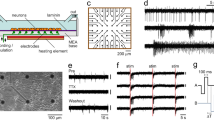Abstract.
The assumption is made that the formulation of relations as independent components (IC) is a main feature of computations accomplished by the brain. Further, it is assumed that memory traces made of non-orthonormal ICs make use of feedback architectures to form internal representations. Feedback then leads to delays, and delays in cortical processing form an obstacle to this relational processing. The problem of delay compensation is formulated as a speed-field tracking task and is solved by a novel control architecture. It is shown that in addition to delay compensation the control architecture can also shape long-term memories to hold independent components if a two-phase operation mode is assumed. Features such as a trisynaptic loop and a recurrent collateral structure at the second stage of that loop emerge in a natural fashion. Based on these properties a functional model of the hippocampal loop is constructed.
Similar content being viewed by others
Author information
Authors and Affiliations
Additional information
Received: 18 March 1997 / Accepted in revised form: 30 June 1998
Rights and permissions
About this article
Cite this article
Lo˝rincz, A. Forming independent components via temporal locking of reconstruction architectures: a functional model of the hippocampus. Biol Cybern 79, 263–275 (1998). https://doi.org/10.1007/s004220050476
Issue Date:
DOI: https://doi.org/10.1007/s004220050476




